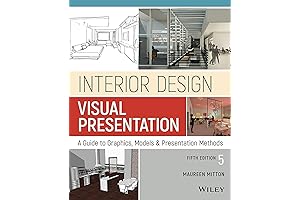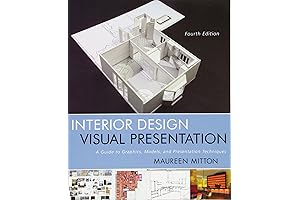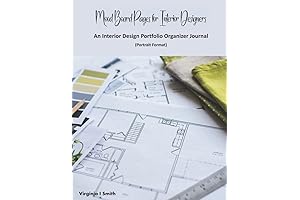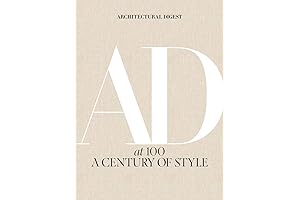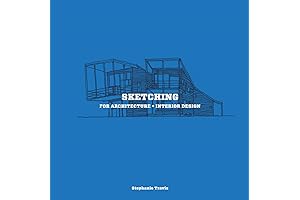· interior design · 13 min read
Exclusive Guide: Mastering Interior Design Visual Presentation
Discover the ultimate guide to interior design visual presentation. Master graphics, models, and techniques to create captivating presentations that will elevate your designs.
Embark on a journey into the world of interior design visual presentation. This comprehensive guide will equip you with the knowledge and skills to showcase your designs with excellence. Dive into the depths of graphics, models, and presentation methods to captivate your audience and leave a lasting impression.
Overview

PROS
- Provides comprehensive guidance on visual presentation techniques for interior design
- Offers practical insights into creating engaging graphics, models, and presentations
CONS
- May be too technical for beginners
- Some examples may not be up to date with current trends
In the realm of interior design, visual presentation reigns supreme. This book, 'The Essential Guide to Interior Design Visual Presentation', serves as an invaluable resource for transforming your design concepts into captivating visuals. Its in-depth coverage of graphics, models, and presentation methods empowers you to create stunning presentations that will leave a lasting impression on clients and stakeholders alike. While it may present some challenges to beginners, its wealth of practical insights, coupled with real-world examples, makes it an indispensable tool for any interior designer seeking to elevate their visual storytelling skills.
The authors have meticulously crafted this guide to guide you through every aspect of visual presentation. From creating visually appealing floor plans to mastering 3D modeling and rendering, they leave no stone unturned. The book's strength lies in its ability to bridge the gap between technical know-how and creative expression, ensuring that your designs are not only visually stunning but also effectively communicate your design intent. Overall, this guide is an essential addition to the library of any aspiring or experienced interior designer who desires to elevate their visual presentation game.

PROS
- Comprehensively covers the principles and practices of interior design visual presentation
- Richly illustrated with inspiring case studies and stunning photography
CONS
- Could benefit from more in-depth coverage of lighting techniques
- Some readers may find the writing style a bit dry
For those seeking to cultivate captivating interior spaces, this comprehensive guide to interior design visual presentation is an invaluable resource. With a keen eye for detail, the book delves into the fundamental principles and practices of crafting visually stunning environments.
Through an engaging combination of insightful text and breathtaking photography, the book provides a thorough exploration of color theory, spatial planning, and the art of accessorizing. Numerous case studies illustrate these concepts in real-world settings, offering practical inspiration for designers and homeowners alike. While the focus on visual presentation is unparalleled, some readers may appreciate additional insights into the role of lighting in interior design. Nevertheless, this guide remains an essential addition to any interior design enthusiast's library, empowering them to transform their spaces into visual masterpieces.

PROS
- Comprehensive coverage of visual communication techniques for interior design professionals
- Expert guidance on creating stunning graphics, models, and presentations that convey design concepts effectively
CONS
- May require a background in graphic design or modeling software for full comprehension
- Some examples and case studies could be more contemporary
The third edition of Interior Design Visual Presentation solidifies its status as an indispensable guide for interior designers seeking to elevate their presentations. This comprehensive volume delves into the intricacies of visual communication, empowering professionals with practical techniques and strategies to convey design concepts with precision and impact.
The book's strength lies in its meticulous organization, with chapters dedicated to various aspects of visual presentation. From creating effective floor plans and renderings to harnessing the power of 3D modeling and virtual reality, the authors provide detailed explanations and step-by-step instructions. The inclusion of real-world examples and case studies further enhances the book's practical value, allowing readers to observe how these techniques are applied in professional settings.

PROS
- Step-by-step guidance on creating stunning visual presentations
- Covers all key aspects of presentation design, from concept to completion
CONS
- Primarily focused on traditional presentation techniques, may not be suitable for digital presentations
- Some of the examples may be outdated
Interior Design Visual Presentation is an indispensable guide for interior designers looking to elevate their presentation game. This comprehensive book covers all the essential steps involved in creating professional-level visual presentations, from brainstorming concepts to delivering impactful presentations. What sets this book apart is its focus on practical, hands-on advice. Author Maureen Mitton provides clear and concise instructions, making it easy for readers to apply the techniques to their own work.
The book is organized into three main sections. The first section covers the fundamentals of presentation design, including principles of visual communication, color theory, and typography. The second section delves into the different types of presentation materials, such as floor plans, elevations, and renderings. And the third section offers guidance on preparing and delivering effective presentations. Throughout the book, Mitton emphasizes the importance of storytelling and audience engagement, helping readers create presentations that not only convey their design ideas but also captivate their audience.

PROS
- Offers a comprehensive exploration of graphic techniques, models, and presentation methods.
- Enhances understanding of the essential design concepts and their visual representation.
CONS
- The examples and projects may not be the latest style representations.
- The focus on digital tools could have been more extensive.
Interior Design Visual Presentation: A Guide to Graphics, Models & Presentation Techniques is an invaluable resource for anyone looking to master the art of visual storytelling for spaces and interiors. This comprehensive guide delves into the fundamentals of graphic techniques, models, and presentation methods, providing a solid foundation for students, instructors, and professionals alike.
The book effectively conveys essential design concepts and their visual representation. The inclusion of diagrams, illustrations, and real-world examples reinforces the key takeaways and encourages readers to apply the knowledge in practical settings. The exploration of digital tools and technologies is particularly notable, as it reflects the ever-evolving nature of the industry.

PROS
- Comprehensive visual presentation tool for interior designers
- Allows for effortless organization and exploration of design ideas
- Ample space for sketches, color swatches, and material samples
- Inspires creativity and facilitates effective communication with clients
CONS
- May require additional materials (e.g., glue, tape) for attaching samples
- Limited to inspiration and concept development; not a comprehensive drafting tool
The Interior Design Mood Board Journal empowers interior designers with a comprehensive visual presentation tool. Its well-organized pages provide ample space for sketches, color swatches, and material samples, allowing for effortless exploration and organization of design concepts.
This journal fosters creativity by providing a dedicated space to experiment with different design elements. It also enhances communication with clients, as designers can easily share their visual inspirations and solicit feedback. Whether you're a seasoned professional or an aspiring designer, this journal is an invaluable resource for bringing your interior design visions to life.

PROS
- Streamline and elevate interior design presentations with professional-quality mood board pages.
- Organize design concepts, inspiration, and project details in a visually stunning format.
CONS
- Primarily designed for portfolio purposes, may not be suitable for detailed project planning.
- Portrait format might limit the size and scope of mood board elements.
Immerse yourself in a world of design possibilities with the 'Interior Design Portfolio Organizer Journal'! Specially crafted for interior designers, this journal empowers you to effortlessly organize your thoughts, inspirations, and project details. Its dedicated mood board pages ignite creativity, allowing you to visually portray design concepts and bring your visions to life.
Gone are the days of scattered notes and chaotic mood boards. This journal provides a structured approach to presenting your design ideas with precision and impact. Sketch out floor plans, jot down color schemes, and assemble fabric swatches - all within the confines of this comprehensive portfolio. Let your creativity soar as you curate visually stunning mood boards that showcase your unique design aesthetic.

PROS
- Unveils the evolution of interior design through captivating visuals of iconic spaces and trendsetting styles.
- Offers a comprehensive overview of the most influential designers, architects, and tastemakers of the past century.
CONS
- Primarily focuses on high-end and luxury design, which may not appeal to all readers.
- Limited coverage of contemporary design trends.
Immerse yourself in the captivating history of interior design with 'Architectural Digest at 100: A Visual Journey Through 150+ Years'. This coffee table book is a visual masterpiece, showcasing the transformative power of design through stunning photography and in-depth analysis. From opulent mansions to cozy abodes, the book chronicles the evolution of taste, technology, and cultural influences that have shaped our living spaces.
Featuring over 150 years of iconic interiors, the book celebrates the legacy of legendary designers like Frank Lloyd Wright, Dorothy Draper, and Billy Baldwin. It explores the interplay between architecture, furniture, textiles, and art, highlighting how each element harmoniously contributes to creating unforgettable spaces. With captivating narratives and exclusive interviews, 'Architectural Digest at 100' invites readers to embark on a journey through the past, present, and future of interior design.

PROS
- Empowers architects and designers with the skills to craft mesmerizing presentations that convey complex design concepts with clarity and impact.
- Provides a comprehensive framework for developing presentations that effectively communicate a project's narrative, technical aspects, and aesthetic qualities.
CONS
- Some readers may find the level of detail overwhelming, especially those with limited experience in presentation design.
- The focus on visual communication may overshadow other crucial aspects of persuasive presentations, such as storytelling and audience engagement.
Immerse yourself in the world of persuasive visual presentations and transform your architectural designs into captivating stories with 'Visual Communication for Architects and Designers.' This comprehensive guide unlocks the secrets of creating presentations that not only showcase your technical prowess but also engage, inspire, and persuade your audience.
Delve into the intricacies of visual storytelling, color theory, typography, and composition to craft presentations that resonate with your viewers. With practical exercises and real-world examples, this book empowers you to develop presentations that effectively convey your design intent, communicate complex information clearly, and leave a lasting impression on your audience. Whether you're an experienced professional or an aspiring architect, 'Visual Communication for Architects and Designers' is the essential tool to elevate your presentation skills and elevate your architectural visions to new heights.

PROS
- Enhances visualization and communication skills for architects and interior designers.
- Provides a solid foundation in fundamental sketching techniques and principles.
CONS
- May not be suitable for advanced sketchers looking for specialized techniques.
This comprehensive guide to sketching for architecture and interior design empowers you to bring your design ideas to life. Through a blend of clear instructions and inspiring examples, you'll master the art of sketching, a crucial skill for effectively communicating your design vision. Ideal for students and aspiring professionals alike, this book provides a solid foundation in sketching fundamentals, enabling you to elevate your visual presentation skills and convey your design concepts with greater clarity and impact.
The book delves into various sketching techniques, from basic linework to perspective and shading, equipping you with the tools to accurately capture spatial relationships and convey the intended ambiance of your designs. By incorporating personal anecdotes and real-world examples, the author brings the subject to life, making the learning process engaging and relatable. Whether you're an architecture student seeking to enhance your visualization skills or an interior designer aiming to communicate your design ideas with precision, this guide is an invaluable resource that will elevate your visual presentation capabilities, ultimately empowering you to create stunning design solutions.
This guidebook serves as an indispensable resource for interior designers seeking to elevate their visual presentations. With its expert insights and practical guidance, you'll gain a competitive edge in creating compelling visuals that effectively communicate your design concepts. Master the art of visual storytelling and leave a lasting impact on your clients.
Frequently Asked Questions
What are the key elements of interior design visual presentation?
Interior design visual presentation encompasses graphics, models, and presentation techniques that effectively convey design concepts. These elements work together to captivate the audience and leave a lasting impression.
How can I improve my visual presentation skills?
To enhance your visual presentation skills, focus on understanding your audience's needs, utilizing high-quality visuals, and employing clear and concise language. Additionally, consider incorporating interactive elements to engage your audience.
What are some best practices for creating compelling visual presentations?
Effective visual presentations prioritize clarity, storytelling, and consistency. Ensure your visuals align with your narrative, maintain a cohesive visual style, and consider the different ways your audience might interact with your presentation.
How can I use visual presentation tools to enhance my designs?
Visual presentation tools empower you to transform your designs into captivating visuals. Utilize these tools to create realistic renderings, interactive floor plans, and immersive 3D models that showcase your designs in the best possible light.
What are common mistakes to avoid in interior design visual presentations?
Common pitfalls to avoid include overcrowding your slides with excessive text or visuals, using low-resolution images, and neglecting the overall flow and consistency of your presentation. Additionally, be mindful of your audience's attention span and cater your presentation accordingly.
